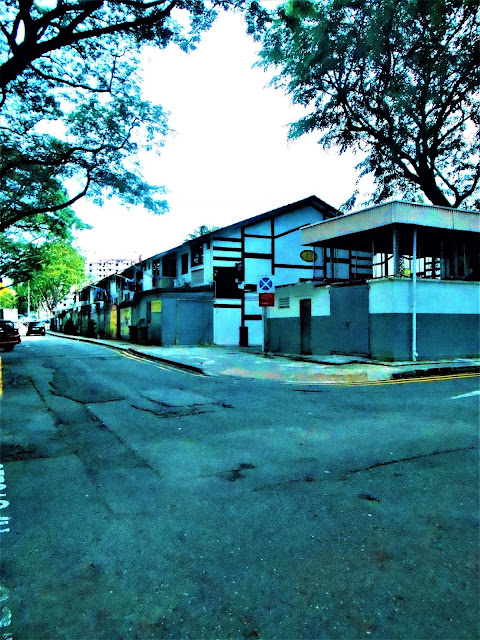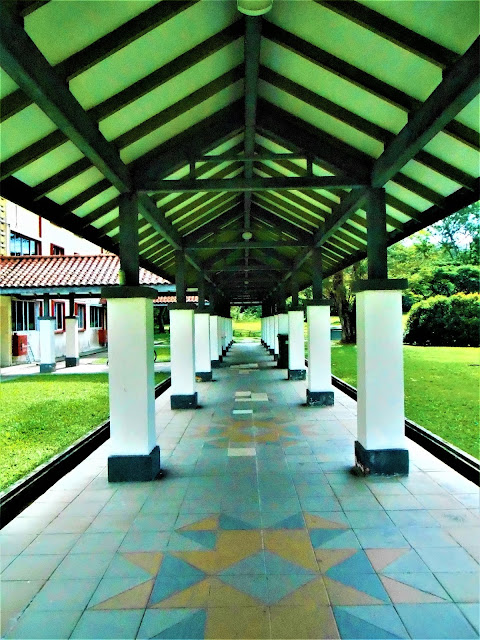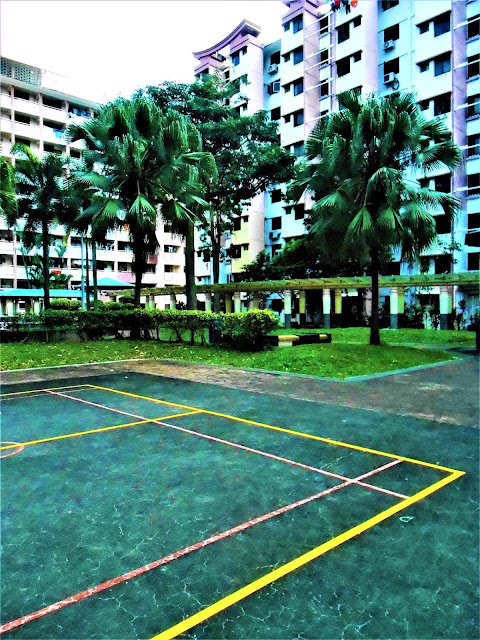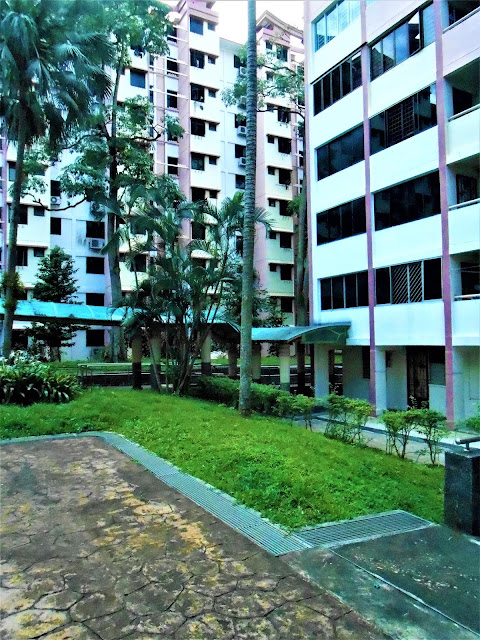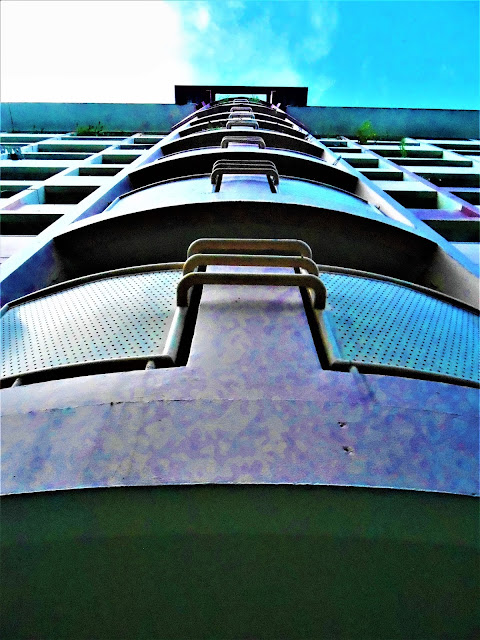Very last minute, and very long delayed this visit to Tanglin Halt was.
I'd actually planned to come here way back in 2014 when the announcement was first made, but then there were things I had to look at in that year- and so it would only be this year (post CB and all) that I found myself standing outside the Sheng Siong supermarket near Commonwealth MRT wondering from where I ought to begin.
One rule I like to follow when I come to places like these is to go wherever I'm inclined to- and continue on from there- so I started by simply walking along the car park at the back of the supermarket, upon which I came to a large field. Near it were blocks of four-storeyed walk-up apartments so I grabbed a few pictures of the trees on the field and crossed over to the blocks there.
Located a mere couple of steps away from the old Malayan Railway Line, I found the design somewhat familiar. I knew I'd seen housing blocks of similar design before- at the (now defunct) housing estate right across the (now-shut) Tanjong Pagar Railway Station just off the west side of town.
It was charming, quiet, peaceful.
I don't know how the families who once lived here used to live, but I imagine they would have been a tight-knit community where the adults worked together and the children played games on the grass in the evenings. There were still several benches here and there where families might have sat as the afternoon shadows turned to skies of dusk.
I went round and round the area surrounding these blocks, not knowing where I should go, not knowing what I wanted to see.
Which, come to think of it, was quite an irony- there being a time when I knew the names of several families living in this estate- and yet had never crossed the road to this side.
One of the most time-wasting things is to be wandering repeatedly about in the same old circle, and just as I was wondering what I ought to do, it suddenly occurred to me that I might have a better idea if I knew the lay of the land (how the estate was laid out), so to one of the higher floors of the taller blocks I went for a quick look-around.
Let's just say I had a slightly better idea.
Back down I went to the four-storeyed blocks- climbing up a few staircases just to sense what the dwellers would have seen when they returned home- there was a broken umbrella tucked behind a pipe and a pair of slippers outside a window (I think it belonged to someone who hadn't yet moved)- and lingering a while longer to appreciate the houses' charm.
Next to these blocks were taller, newer, more brightly painted ones- all laid out one behind the other.
Without the bright colors and the carefully landscaped plants between the blocks, the place might have looked rather stark, but the mid-afternoon sun shone cheerfully that day and the plants threw gorgeous shadows all over the paved paths.
Seeing the estate this way made me realize just how often it is that we rush through life without stopping to look around us, and maybe- just maybe- it would do us good to step back and look around us with a new set of eyes.
I didn't stay very long amongst these blocks.
There were other blocks I felt I should also see.
So I departed this side of Tanglin Halt, saying a pensive farewell to the four-storeyed blocks and to the back doors of the ground-floor flats that once opened out to a shared rectangular grass patch separating them and their neighbors opposite.
One day the remnants of those who once lived here- the old brooms, the dustpans, the air con compressors, the mops, the stools, the basins- would be cleared off and disappear.
Today, however, was not yet the day.
Across the road (I think it was Commonwealth Drive?) I went after, stopping first for a breather (and a drink of water) on an open-air bird poo-splattered seat and randomly grabbing a pathway picture.
The blocks opposite the road looked to be slightly different from the ones I'd seen a few minutes earlier.
No doubt, I'm a heartlander, yes, and I'm very used to seeing different blocks at different sections in a single housing estate, but seldom is it that I find two starkly different designs situated right next to each other separated only by a narrow two-lane road.
It took me a while to figure it out, but I think it might have been how the open spaces were arranged.
Where at the previous side they were more cloistered, with benches nestled amongst the shrubs, here everything was more spaced out.
If the plants and shrubs over there were placed between the open spaces, here the tall trees served as a sort of border surrounding a space that at other times could have been a central event space, sort of like a piazza.
I might be wrong but the place seemed to be more sparse, emptier, even quieter. Most of the corridors were bare- no clotheslines hung between the pillars outside the homes, no potted plants lined the walls stretching their stems out towards the sunshine, and almost no laundry hanging on bamboo poles outside the kitchen windows.
Maybe more residents this side of the road had moved away.
But because I wanted to capture the feel of the place, I decided it be a good idea to plonk myself down on the terraced concrete at the piazza just like many a former resident would have done.
At one time this place would have been livelier- there might have been youth shooting baskets at the basketball court, there might have been girls sitting on these same terraced seats watching the boys play basketball, there might even have been cats taking an afternoon roam about.
But this place wasn't entirely devoid of life.
No, it was still a shelter and a home to the children who came scooting behind me as their mothers settled on a stone bench a short distance away. Dressed in home clothes of faded singlets, T-shirts and shorts, happily they ran about, chasing each other.
Something about their laughter, their chuckles and their excited screams made me smile.
Above me the occupants might have grown up, shut the door, and moved on, but wherever it remains a shelter and a home, there laughter, games, life and new memories will be.
It didn't matter if the basketball court had a couple of unsightly patches here and there.
It didn't matter if the paint on certain walls of the open spaces had faded, had scuff marks or even peeled.
This was not a neighborhood on its way out.
Neither was it a neighborhood where the residents lived only the lives of the yesterday and not of today.
No, absolutely not.
There were people on slow evening walks around the circumference of the blocks.
A mobile transport dropped off an elderly woman in a wheelchair to her waiting husband after her hours at senior daycare.
And working adults traipsed back up to their flats bearing little plastic bags of their packet dinners in hand.


